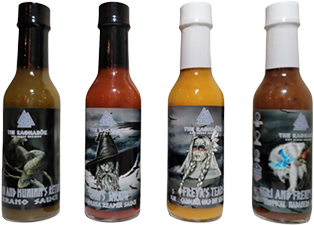In the expansive realm of culinary experiences, a remarkable category emerges, infusing every meal with a punch, a kick, and an explosion of flavors – spicy condiments. These zesty companions go beyond geographical boundaries and culinary traditions, seamlessly integrating into the global palate. Furthermore, this exploration into the fiery allure of spicy sauces unravels their origins, unveils their cultural significance, and celebrates the diverse array of options available to suit every heat preference. From the vibrant salsas of Latin America to the aromatic spices of Southeast Asia, these condiments weave a rich tapestry of tastes, transforming meals into vibrant and dynamic culinary experiences.
The Evolution of Spicy Condiments:
The rich history of condiments is an intricate tapestry woven with culinary exploration and innovation threads, spanning centuries of global gastronomy. This culinary love affair with heat transcends cultural boundaries, expressing diverse condiments passed down through generations. In fact, from the zesty salsas of Mexico to the aromatic Sriracha originating in Southeast Asia, each spicy sauce encapsulates a narrative of culinary heritage, reflecting the dynamic evolution of flavors across continents.
In addition to this, dating back to ancient Rome, mustard is one of the earliest recorded condiments, marking a pivotal moment in the quest for bold flavors. Its usage in ancient times extended beyond mere taste, as mustard was valued for its fiery flavor and preservative properties. As centuries unfolded, mustard underwent a fascinating metamorphosis, adapting to local palates and preferences. This adaptability is vividly illustrated by the emergence of distinct regional varieties, such as the sophisticated Dijon mustard in France and the robust English mustard in the United Kingdom. However, these transformations underscore the versatility of condiments and their ability to evolve with the changing culinary landscape.
Cultural Significance:
These condiments often hold deep cultural significance as a culinary and symbolic representation of a community’s identity. In many Asian cuisines, chili sauces and pastes are emblematic of the bold and intense flavors that characterize the region’s culinary landscape. For example, gochujang in Korean cuisine and sambal in Indonesian and Malaysian cuisines are integral to many traditional dishes, adding layers of complexity and heat.
In fact, In Latin American cultures, salsas and hot sauces play a central role in enhancing the vibrancy of dishes. Whether it’s the smoky chipotle salsa in Mexico or the tangy aji amarillo sauce in Peru, these condiments reflect the diversity and richness of Latin American gastronomy.
The Global Heat Wave:
As global travel and cultural exchange have become more accessible, the popularity of condiments has soared. The ubiquitous sriracha sauce, originating from Thailand, has become a household name worldwide. Its harmonious blend of heat, sweetness, and tanginess has made it a staple not only in Asian cuisine but also in fusion dishes that crave a spicy kick.
Similarly, the rise of hot sauce culture, particularly in the United States, has given birth to many artisanal options. From Carolina Reaper-infused sauces that boast record-breaking heat levels to fruit-infused habanero blends. Therefore, the world of spicy condiments is as diverse as the peppers from which they are crafted.
Exploring Spicy Condiment Varieties:
1. Sriracha: The Global Darling:
Sriracha stands as the epitome of a global hot sauce phenomenon, adorned with its vibrant red hue and iconic rooster logo. Originating from the culinary landscape of Thailand, Sriracha has seamlessly transcended cultural boundaries to become a ubiquitous presence in kitchens worldwide. Its widespread popularity is evident as it effortlessly integrates into diverse cuisines. Appearing in everything from burgers to pizzas and cocktails. Moreover, the allure of Sriracha lies in its impeccable balance of heat, sweetness. And subtle garlic undertones, rendering it a beloved and versatile addition to an extensive array of dishes.
2. Harissa:
The Jewel of North Africa: Harissa, often hailed as the jewel of North Africa, emerges as a spicy condiment that has garnered international acclaim for its rich and invigorating flavors. Crafted from a harmonious blend of roasted red peppers, chili peppers, garlic, and aromatic spices, harissa contributes depth and warmth to various culinary creations. However, originating from the culinary traditions of Morocco and Tunisia, harissa has evolved into a versatile ingredient. That has found its place in the heart of Mediterranean and Middle Eastern cooking. Without doubt, its ability to elevate the taste profile of dishes has solidified harissa’s status as a culinary gem. Adding a touch of North African flair to kitchens around the globe.
3. Gochujang: Korea’s Umami Bomb:
Gochujang, a cornerstone of Korean cuisine, emerges as a fermented chili paste that embodies the perfect fusion of sweet, savory, and spicy notes. Therefore, this umami bomb is a critical player in iconic Korean dishes like bibimbap and bulgogi. Imparting a uniquely rich and complex flavor to every bite. Beyond its traditional applications, gochujang’s versatility shines through as it ventures into global kitchens. Becoming a sought-after ingredient for those seeking to infuse depth and character into their culinary creations. Undoubtedly, with its transformative properties, gochujang has secured its place as a staple that transcends cultural boundaries and offers a delectable journey into the heart of Korean gastronomy.
The Art of Making Condiments at Home:
Crafting homemade condiments is a rewarding and creative endeavor for culinary enthusiasts. Thus, the process allows for customization, enabling individuals to tailor the heat level and flavor profile and even experiment with unique ingredients. The possibilities are endless, whether fermenting chili peppers for a hot sauce or blending fresh herbs for a fiery chimichurri.
A simple recipe for a homemade spicy condiment:
Chili Infused Olive Oil:
Ingredients:
- 1 cup extra-virgin olive oil
- 3-4 dried red chili peppers
- 2 cloves garlic, crushed
- 1 teaspoon crushed red pepper flakes (optional for extra heat)
- Salt to taste
Instructions:
- In a small saucepan, heat the olive oil over low-medium heat.
- Add the dried red chili peppers and crushed garlic to the oil.
- Allow the mixture to simmer gently for 5-7 minutes, infusing the oil with the flavors of the chili and garlic.
- Stir in the crushed red pepper flakes and a pinch of salt if desired.
- Remove from heat and let the oil cool to room temperature.
- Strain the oil to remove the chili peppers and garlic, leaving behind a fragrant and spicy chili-infused olive oil.
However, this versatile condiment can be drizzled over pizzas, pasta, or grilled vegetables, adding a delightful kick to your favorite dishes.
In Conclusion:
In the dynamic and ever-evolving realm of culinary trends, spicy condiments emerge as enduring taste icons, serving as timeless and transformative flavor enhancers. These fiery companions, rooted in historical traditions and fueled by contemporary global popularity. And for that reason, they are become integral to the gastronomic experience. Leaving an indelible mark on how we savor and appreciate food. Their rich history, often intertwined with cultural narratives. Adds depth to the culinary landscape, showcasing the universality of the human affinity for heat and spice.
To conclude more, for enthusiasts and home cooks alike, condiments beckons as a realm of limitless exploration. Whether you’re a connoisseur pursuing the following artisanal hot sauce to grace your palate or a culinary adventurer experimenting with creating homemade chili oils. The diversity and dynamism of condiments offer an exciting journey. With every dash, drizzle, or dollop, these condiments not only heighten the sensory experience of a dish. But also invite individuals to infuse their culinary
repertoire with boldness and creativity. So, as you Get on this fiery gastronomic journey, embracing the heat and variety that condiments bring. Prepare to raise your culinary endeavors to new, flavorful heights.




